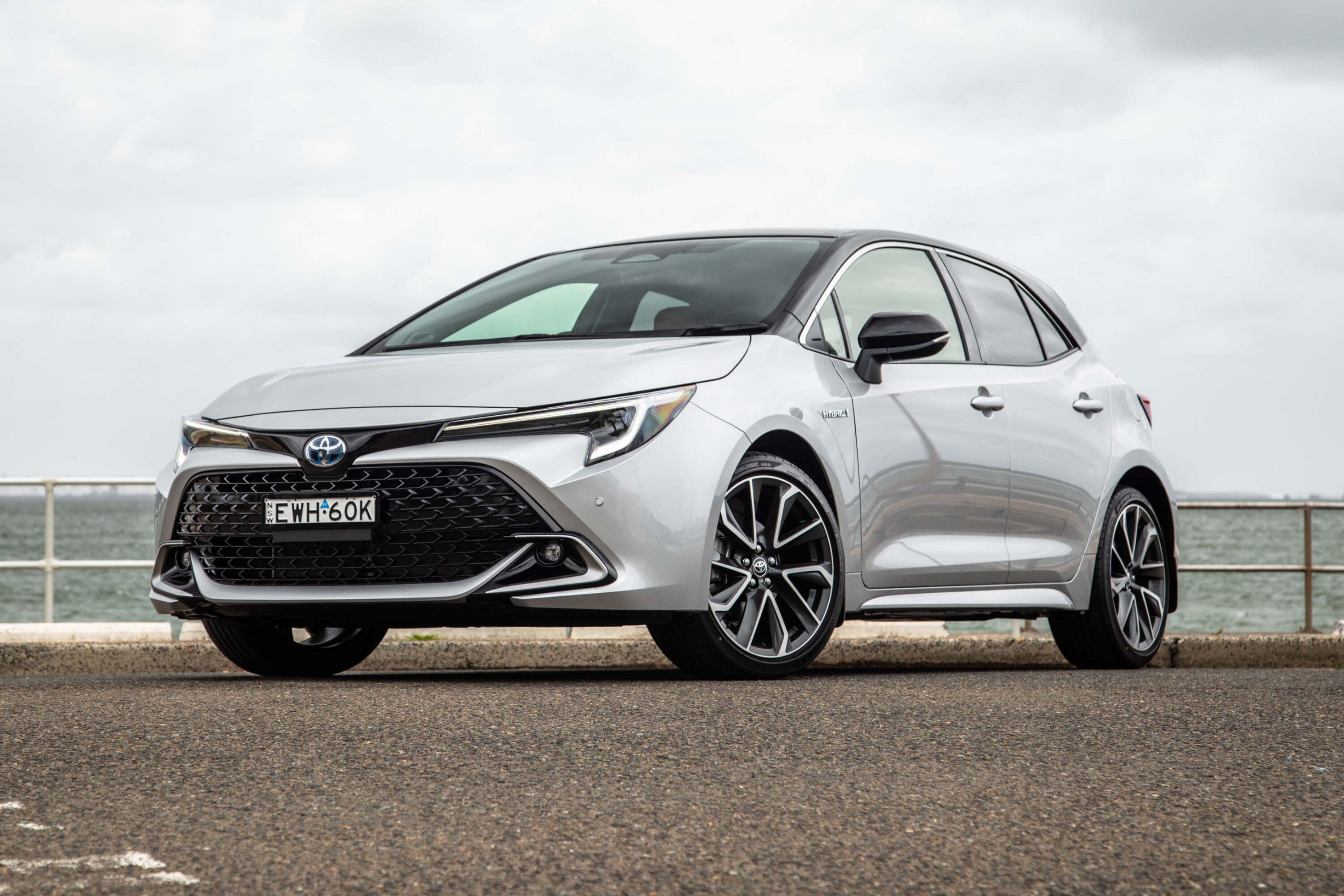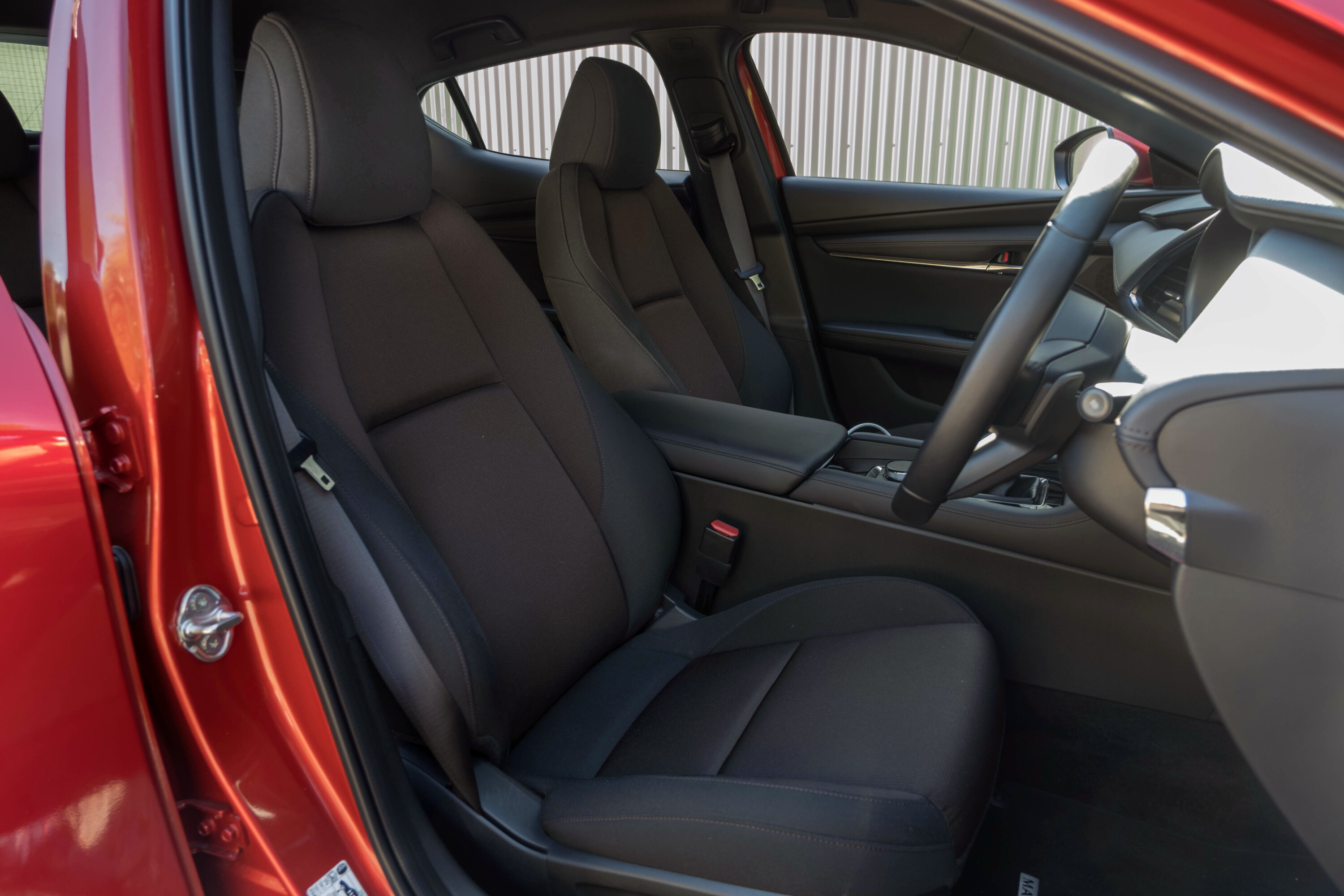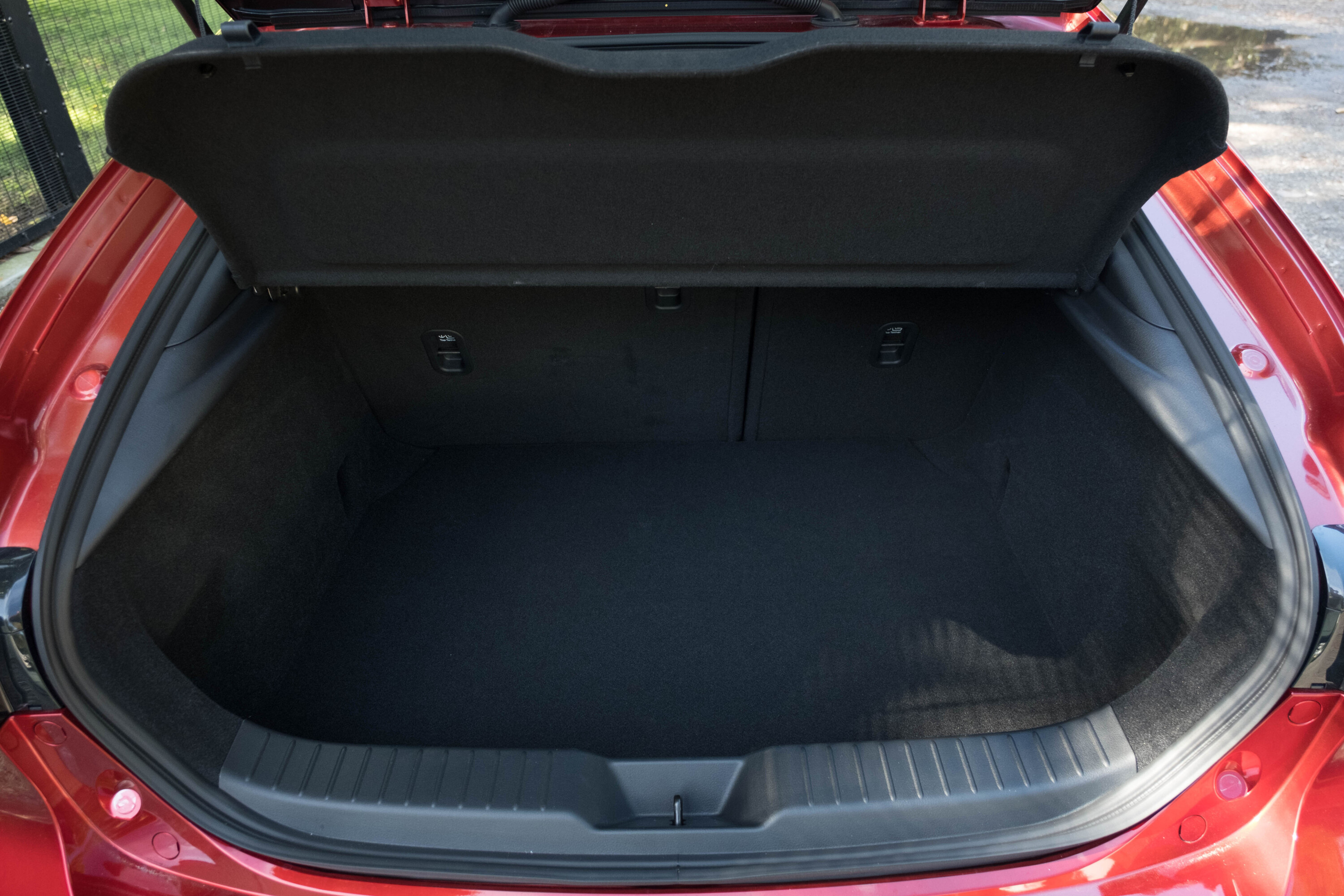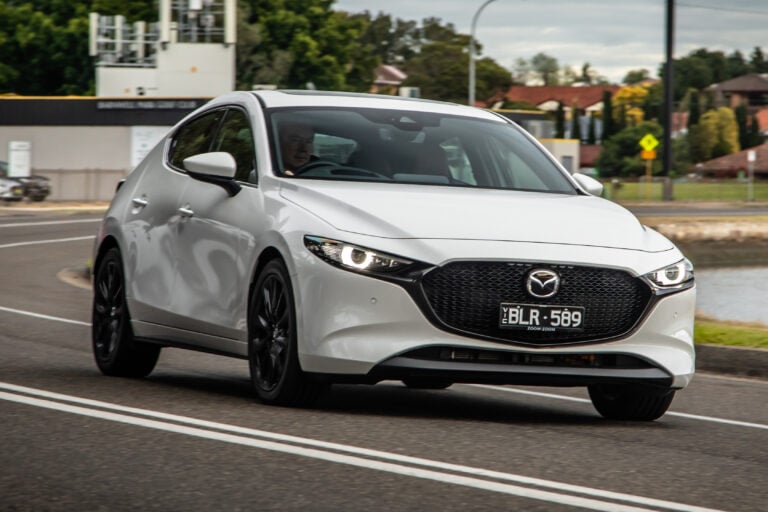Score breakdown
Things we like
- Lovely interior
- Well-judged chassis
- Gorgeous to look at
Not so much
- Slow
- A little dark inside
- Slippy tyres
The Mazda 3 is still doing the numbers for Mazda and as well it should. A polished performer with two very distinct bodystyles, it’s a car that oozes confidence.
Mazda’s own success at turning out SUVs has probably been to the detriment of the 3 just as much as any other company’s success at the larger format has been to their own hatchbacks. But where others have shrunk into themselves and delivered conservative-looking hatches, Mazda pushed out the boat and re-ignited the fire that went out in the 1990s with the demise of the gorgeous 323 and 323 Astina.
Some don’t like that big fat C-pillar, but I think it elevates the car into something truly different without going all Zorro with slashes and creases.
As with all 2.0-litre Mazdas, however, I approached this one with caution. As light as the 3 might be, this base engine in the mid-spec Evolve struggles a little. But given that the rest of the car is rather nice, does it matter all that much?

JUMP AHEAD
- How much is it, and what do you get?
- How do rivals compare on value?
- Interior comfort, space and storage
- What is it like to drive?
- How much fuel does it use?
- How safe is it?
- Warranty and running costs
- VERDICT
- Specifications
How much is it, and what do you get?
This is kind of a review of the Evolve more than the G20e itself, but as there is likely still stock kicking around, it’s worth mentioning that there is a fairly important price difference.
The G20e Evolve M Hybrid hatch goes for $33,460 while the automatic Evolve with the standard SkyActiv 2.0-litre is $29,710 (as of May 2023, both before on-road costs).

Part of the price difference between the standard G20 and G20e can be explained by the $1500 Vision Technology Pack coming as standard (see the safety section) and the rest, well, the mild hybrid system that nobody wanted and from July is no longer available, going the same way as manual transmission-equipped 3s, which is a shame.
| 2023 Mazda 3 G20 Evolve standard features | |
|---|---|
| 18-inch wheels | Dual-zone climate control |
| 8-speaker stereo | Electric driveru2019s seat |
| 8.8-inch media screen | Keyless entry and start |
| Adaptive cruise control | Leather gear selector |
| Auto high beam | Leather steering wheel |
| Auto wipers | Power-folding mirrors |
| Automatic LED headlights | Satellite navigation |
| Cloth seats | Wired Android Auto |
| DAB+ digital radio | Wired Apple CarPlay |

How do rivals compare on value?
The Mazda 3 rumbles enthusiastically with the Toyota Corolla, in this case, the most likely combatant being the Ascent Sport Hybrid for $31,130 or the SX Hybrid for $34,280 (both before on-road costs). Each Toyota has a proper hybrid system, is cheaper to service and returns lower fuel consumption.
Hyundai’s i30 is getting a bit long in the tooth, with the Elite auto topping the 2.0-litre naturally-aspirated range with a $30,800 before on-road costs price tag. It’s not available as a hybrid because Hyundai is yet to add any form of electrification to its popular hatchback.
The Kia Cerato is a similar story but with more room than either of these machines. At $31,440 before on-road costs, it’s in the mix with the G20e but slightly more than the G20.
None of the 3’s rivals are, to my eyes, better looking inside or out and the Korean machines don’t have as much in the way of safety tech.

Interior comfort, space and storage
Mazda is doing its very best to inch its way upmarket and interiors form a big part of that strategy. This generation of 3 launched with a very slick cabin, easily the best in the segment. Lots of very nice materials, even in a sub-$30K car; even the cloth seats are quite nice and, as ever, my personal preference.
The front seats look pretty good and are equally pleasant to sit in. The lovely Mazda steering wheel is, as my descriptor suggests, very nice indeed. One of the things about the first-generation Mazda 3 – a car I owned and did not like – was that all the touchpoints were nice but not much else was.

A couple of decades down the track, the niceness has moved from just the bits you touch to most of the things you can see. There aren’t many buttons and the low-noise, sleek design is almost calming.
You get a pair of cup holders, a slot under the climate controls for your phone, bottle holders and a bin under the armrest. As part of the commitment to an uncluttered cabin, the latter houses USB-A ports for the media system.
The rear seat is, unfortunately, pretty tight and a bit grim. It’s comfortable enough but there’s only just sufficient legroom for me at 180cm slotted in behind my driving position. The chunky C-pillar cuts into the rear glass, too, meaning there’s not a great deal of light back here. You do get air vents, but there’s no USB port.

What is it like to drive?
Every Mazda car or SUV is good to drive, with adequate power and torque but a chassis that wants to play while also delivering a good experience for everyone in the car.
| G20e | G20 | |
|---|---|---|
| Engine | 2.0-litre naturally-aspirated four-cylinder mild hybrid | 2.0-litre naturally-aspirated four-cylinder petrol |
| Transmission | 6-speed automatic | 6-speed automatic |
| Power | 114kW @ 6000rpm | 114kW @ 6000rpm |
| Torque | 200Nm @ 4000rpm | 200Nm @ 4000rpm |
As you can see, the G20e and G20 have identical power and torque figures at 114kW/200Nm, with the G20e featuring a (very) mild 24-volt hybrid system. As with other mild setups, it’s essentially a more powerful stop-start system with a little bit of extra torque to send back through to the front wheels. It also means an imperceptibly smooth engine cut-out and cut-in.

For the driver, the controls are just right – a bit of weight in the steering, nicely balanced brakes and tons of grip, in the dry at least. It’s such a nice car to drive around in, with a really lovely balance.
The suspension is taut without being crashy or firm, noticeably so over its immediate competition. There’s a quality to the way it rides and handles that is woven through the Mazda range, whether it’s the monster CX-9 or the tiny 2. While an i30 or a Corolla is nice to drive, a 3 is good to drive.
It’s just a pity that the tyres fitted from the factory are so slippy in greasy conditions, something I’ve always noticed on front-wheel drive Mazdas.

There’s an issue with the G20 and G20e. Well, it’s one issue that spawns a few more. There’s not much power on offer so progress is somewhat leisurely. That’s completely fine if you’re not that fussed with a slowish car and you don’t have to break into traffic or overtake on single-carriageway roads.
Its less-than-stellar outputs mean that if you are fond of quicker progress, you’re going to zip through petrol at a fairly rapid rate, at least compared to the official figure. It’s about right compared to its immediate competition except for the hybrid Corolla.

How is it on fuel?
As you can see from the table below, your extra few thousand dollars – let’s be generous and drop the $1500 safety additions) – buys you just 0.2 litres fewer per 100km on the official combined cycle. It’s hardly compelling, as Mazda has conceded.
| G20e Evolve | G20 Evolve | |
|---|---|---|
| Claimed fuel consumption (combined) | 6.0L/100km | 6.2L/100km |
| On-test fuel consumption (indicated) | 9.2L/100km | N/A |
| Fuel tank capacity | 51 litres | 51 litres |
| Projected real-world range | 283km | N/A |
| Fuel type | 91 RON | 91 RON |
My experience – and that of others – is that the 2.0-litre in the 3 misses its numbers by a fair margin, whether it’s this mild hybrid or the standard SkyActiv. The 2.5-litre is a better buy if you like a bit more power and it barely uses any more fuel day-to-day than the 2.0-litre because it’s a more relaxed engine.

How safe is it?
The Mazda 3 range scored five ANCAP stars in 2019 with what was at the time a class-leading safety list and one that embarrasses some much more expensive cars.
| 2023 Mazda 3 G20 Evolve safety features | |
|---|---|
| 7 airbags (including driveru2019s knee airbag) | Lane-keep assist |
| ABS | Rear cross-traffic alert |
| Blind-spot monitoring | Reverse AEB |
| Driver attention monitoring | Reversing camera |
| Forward auto emergency braking | Stability and traction controls |
| Lane departure warning | Tyre pressure monitoring |

The Vision Technology Pack is standard on the G20e ($1500 on the G20) and adds:
| 2023 Mazda 3 G20 Vision Technology Pack | |
|---|---|
| 360-degree cameras | Front cross-traffic alert |
| Front parking sensors | Driver monitoring |
| Stop-and-go traffic jam assist | |
You also get the usual two ISOFIX points and three top-tether anchors.

Warranty and running costs
The Mazda 3 comes with a five-year, unlimited-kilometre warranty and roadside assistance.
A capped-price servicing regime runs for the first five services for a total cost of $1766 or an average of $353 each. There are also some extras listed on the website, such as brake fluid and filters, which are reasonably priced.

VERDICT
Does it matter that the 2.0-litre is a bit slow? No.
The thing about the Mazda 3 is that it’s a really good car. Not everyone wants or needs the extra power of the 2.5-litre and saving a few bucks on the upfront cost of that car can only enhance the ownership prospect for some folks, especially if it’s the go/no-go decision point.
Discontinuing the mild hybrid is absolutely a no-brainer because it wasn’t any better in the real world, so in the absence of a proper hybrid system, the 2.0-litre made the most sense, especially given the minuscule fuel consumption advantage.

The 3 remains a lovely car in hatchback form, despite its rear seat’s shortcomings. It’s one of the nicest cars of its type to look at, as well as from behind the wheel. And in a world of ever-increasing costs, scoring a pretty car in lovely colour with all of these qualities for less than thirty grand is a bit of a win.
| Mazda 3 G20e Evolve | Mazda 3 G20 Evolve | |
|---|---|---|
| Body | 5-door, 5-seat small hatchback | 5-door, 5-seat small hatchback |
| Drive | front-wheel | front-wheel |
| Engine | 2.0-litre naturally-aspirated four-cylinder mild hybrid | 2.0-litre naturally-aspirated four-cylinder petrol |
| Transmission | 6-speed automatic | 6-speed automatic |
| Power | 114kW @ 6000rpm | 114kW @ 6000rpm |
| Torque | 200Nm @ 4000rpm | 200Nm @ 4000rpm |
| Compression ratio | 13.0:1 | 13.0:1 |
| Fuel consumption | 6.0L/100km (combined) | 6.2L/100km |
| Weight | 1361kg | 1338kg |
| Suspension | MacPherson strut front/multi-link rear | MacPherson strut front/multi-link rear |
| L/W/H | 4460mm/1795mm/1435mm | 4460mm/1795mm/1435mm |
| Wheelbase | 2725mm | 2725mm |
| Brakes | ventilated disc front/solid disc rear | ventilated disc front/solid disc rear |
| Tyres | 215/45 R18 | 215/45 R18 |
| Wheels | 18-inch alloy (space-saver spare) | 18-inch alloy (space-saver spare) |
| Price | $33,460 + on-road costs | $29,710 + on-road costs |
Score breakdown
Things we like
- Lovely interior
- Well-judged chassis
- Gorgeous to look at
Not so much
- Slow
- A little dark inside
- Slippy tyres
We recommend
-
 News
News2022 Mazda 3 price and features
The premium audio system has been removed from the mid-spec Mazda 3 G25 GT, with pricing bumped up across the entire range
-
 Reviews
Reviews2022 Mazda 3 G25 Evolve SP sedan review
Mazda adds the SP black pack treatment to the Evolve version of its 3 sedan but hasn't had to do much else to keep it fresh
-
 News
NewsNew car calendar 2026: All the new cars coming to Australia next year
Here’s the WhichCar by Wheels guide to all the new cars that will launch in Australia in 2026. Check back in regularly for updates...






